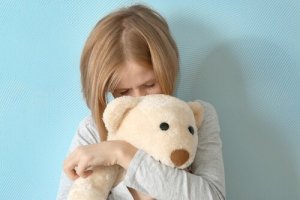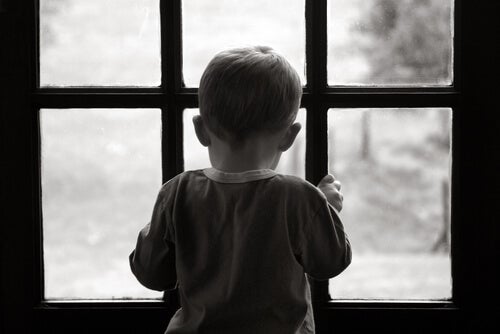Childhood Depression - Effective Interventions

Childhood depression affects as many children as it affects adults. However, it’s important to know how to make a good differential diagnosis with some behavioral disorders that may manifest with a similar clinical picture.
During childhood, depression usually manifests as irritation more than sadness. Depressed children also tend to have more sleep problems. Childhood depression has a similar incidence in both sexes. However, it all changes during adolescence, where it mainly affects females and stays that way until adulthood.
The factors behind childhood depression are varied. The combination of genetic or hereditary variables and a dysfunctional environment can definitely propitiate it.
If either parent is or has been depressed, it’s much more likely that the child will also suffer from this condition at some point in their life. School, extracurricular requirements, and authoritative and contradictory orders are also risk factors.
We’d like to tell you more about the most effective psychological treatments currently available to treat childhood depression. The good news is that children benefit more from psychological therapy than adults.
“Childhood depression tends to be more common in inner cities, being most frequently related to serious social deprivation, bullying, domestic violence, wartime experience, and famine.”
-Robert Winston-
Treatments for childhood depression

Regarding pharmacotherapy, we can indicate that while both pharmacological and psychological therapies are effective in the treatment of adult depression, and both are considered first choice alternatives, in the case of childhood and teen depression, only psychological therapy has enough empirical endorsement.
Therefore, drugs in children are less effective than in adults and produce more side effects. Regarding existing therapies, we can point out the following:
Stark’s self-control therapy
It’s based on the Rehm model, which considers that depression is due to failures in the processes of self-observation, self-assessment, and self-administration of contingencies. The goal here is to select and record the pleasant activities they do, assess their mood, and focus attention on the delayed consequences, not the immediate ones, of doing all this. It’s important to teach the child to reinforce their achievements and to value them realistically.
Kahn’s self-modeling program for child and teen depression
This is the recording of a video of the typical behavior of the depression of each school-aged child during the baseline period. Someone selects a set of behaviors incompatible with depression, verbalized both overtly and covertly. The child then rehearses such incompatible behaviors and records a video. Subsequently, they can watch the video and see themselves acting positively.
Rothbaum’s primary and secondary control enhancement training
This is a cognitive-behavioral treatment based on the model of two control processes:
- Primary. These intend to modify the objective conditions of a child’s life.
- Secondary. These change the subjective, such as beliefs. Its components are pleasant activities, self-control, cognitive restructuring, and progressive relaxation.
Méndez’s Program: Emotion-Action-Behavior
It includes three main components:
- Emotional education
- Pleasant activities
- Cognitive restructuring
There may be other procedures depending on the functional analysis of the particular case, such as sleep hygiene or problem-solving. This takes place through group games such as “emotional charades” or activity cards. Parental involvement is important here. They can act as professionals or co-therapists, but also as patients. This is a treatment that doesn’t take into account the use of drugs.
Lewinsohn’s coping with depression course
It’s a treatment designed for teenagers. The format is for a group of ten teenagers, but they can also work with individuals. The goal is to teach new skills to achieve positive reinforcement and replace destructive thoughts with constructive ones. Some of its components are self-control, social skills, pleasant activities, relaxation, cognitive restructuring, conflict resolution, communication, maintenance of the achievements, and parental involvement.
Brent’s cognitive behavioral therapy for teens
This is a Beck-style cognitive therapy. In addition, adolescents are instructed in social and communication skills. Emotional education is also important, using the “feeling thermometer” to do so. There’s also a problem-solving component.
Conclusion

It’s important to prevent childhood depression. To do so, a good start would be to educate parents as well as emphasize the need to establish firm and safe limits for children.
Similarly, an environment rich in positive reinforcement can also prevent the development of childhood depression. For this, it’s essential for parents to understand how positive it is for their children to have a substantial time of free play on their own or with other children.
Correction must be in line with their conduct and always with a non-punitive objective. Obviously, physical punishment is highly discouraged in any of its forms, even if it’s mild.
However, if the child already displays symptoms of depression, then cognitive behavioral therapy should be the first choice of treatment.
For teenagers, the two alternatives of choice are both cognitive-behavioral and interpersonal therapy. Both therapies have at least two experimental intergroup studies in which it’s been proven that the treatment is statistically superior to the lack of intervention or a placebo.
Childhood depression affects as many children as it affects adults. However, it’s important to know how to make a good differential diagnosis with some behavioral disorders that may manifest with a similar clinical picture.
During childhood, depression usually manifests as irritation more than sadness. Depressed children also tend to have more sleep problems. Childhood depression has a similar incidence in both sexes. However, it all changes during adolescence, where it mainly affects females and stays that way until adulthood.
The factors behind childhood depression are varied. The combination of genetic or hereditary variables and a dysfunctional environment can definitely propitiate it.
If either parent is or has been depressed, it’s much more likely that the child will also suffer from this condition at some point in their life. School, extracurricular requirements, and authoritative and contradictory orders are also risk factors.
We’d like to tell you more about the most effective psychological treatments currently available to treat childhood depression. The good news is that children benefit more from psychological therapy than adults.
“Childhood depression tends to be more common in inner cities, being most frequently related to serious social deprivation, bullying, domestic violence, wartime experience, and famine.”
-Robert Winston-
Treatments for childhood depression

Regarding pharmacotherapy, we can indicate that while both pharmacological and psychological therapies are effective in the treatment of adult depression, and both are considered first choice alternatives, in the case of childhood and teen depression, only psychological therapy has enough empirical endorsement.
Therefore, drugs in children are less effective than in adults and produce more side effects. Regarding existing therapies, we can point out the following:
Stark’s self-control therapy
It’s based on the Rehm model, which considers that depression is due to failures in the processes of self-observation, self-assessment, and self-administration of contingencies. The goal here is to select and record the pleasant activities they do, assess their mood, and focus attention on the delayed consequences, not the immediate ones, of doing all this. It’s important to teach the child to reinforce their achievements and to value them realistically.
Kahn’s self-modeling program for child and teen depression
This is the recording of a video of the typical behavior of the depression of each school-aged child during the baseline period. Someone selects a set of behaviors incompatible with depression, verbalized both overtly and covertly. The child then rehearses such incompatible behaviors and records a video. Subsequently, they can watch the video and see themselves acting positively.
Rothbaum’s primary and secondary control enhancement training
This is a cognitive-behavioral treatment based on the model of two control processes:
- Primary. These intend to modify the objective conditions of a child’s life.
- Secondary. These change the subjective, such as beliefs. Its components are pleasant activities, self-control, cognitive restructuring, and progressive relaxation.
Méndez’s Program: Emotion-Action-Behavior
It includes three main components:
- Emotional education
- Pleasant activities
- Cognitive restructuring
There may be other procedures depending on the functional analysis of the particular case, such as sleep hygiene or problem-solving. This takes place through group games such as “emotional charades” or activity cards. Parental involvement is important here. They can act as professionals or co-therapists, but also as patients. This is a treatment that doesn’t take into account the use of drugs.
Lewinsohn’s coping with depression course
It’s a treatment designed for teenagers. The format is for a group of ten teenagers, but they can also work with individuals. The goal is to teach new skills to achieve positive reinforcement and replace destructive thoughts with constructive ones. Some of its components are self-control, social skills, pleasant activities, relaxation, cognitive restructuring, conflict resolution, communication, maintenance of the achievements, and parental involvement.
Brent’s cognitive behavioral therapy for teens
This is a Beck-style cognitive therapy. In addition, adolescents are instructed in social and communication skills. Emotional education is also important, using the “feeling thermometer” to do so. There’s also a problem-solving component.
Conclusion

It’s important to prevent childhood depression. To do so, a good start would be to educate parents as well as emphasize the need to establish firm and safe limits for children.
Similarly, an environment rich in positive reinforcement can also prevent the development of childhood depression. For this, it’s essential for parents to understand how positive it is for their children to have a substantial time of free play on their own or with other children.
Correction must be in line with their conduct and always with a non-punitive objective. Obviously, physical punishment is highly discouraged in any of its forms, even if it’s mild.
However, if the child already displays symptoms of depression, then cognitive behavioral therapy should be the first choice of treatment.
For teenagers, the two alternatives of choice are both cognitive-behavioral and interpersonal therapy. Both therapies have at least two experimental intergroup studies in which it’s been proven that the treatment is statistically superior to the lack of intervention or a placebo.
All cited sources were thoroughly reviewed by our team to ensure their quality, reliability, currency, and validity. The bibliography of this article was considered reliable and of academic or scientific accuracy.
- American Psychiatric Association (APA) (2014): Manual de Diagnóstico y Estadísitico de los Trastornos Mentales, DSM5. Editorial Médica Panamericana. Madrid.
- Comeche, M y Vallejo, P, M (2016). Manual de Terapia de Conducta en la infancia. 3º edición. Editorial: Dykinson-Psicología
This text is provided for informational purposes only and does not replace consultation with a professional. If in doubt, consult your specialist.







